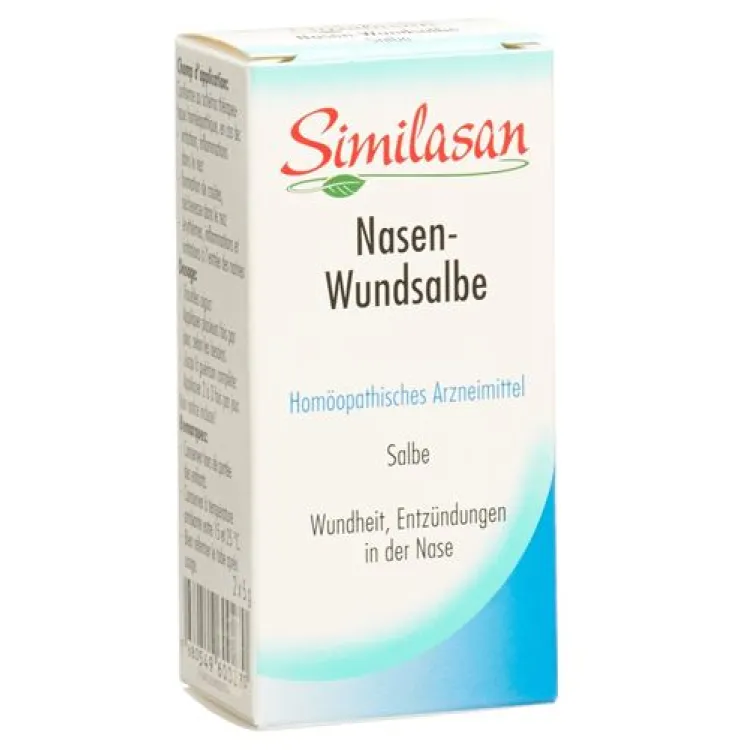Similasan nasal wound ointment 2 x 5 g
Similasan Nasen-Wundsalbe 2 x 5 g
-
44.42 USD

- Availability: In stock
- Distributor: SIMILASAN AG
- Brand: Similasan
- Product Code: 5480364
- ATC-code R01Z
- EAN 7680549600270
Ingredients:
Description
When is SIMILASAN nasal wound ointment used?
According to the homeopathic drug picture, SIMILASAN nasal wound ointment can be used for:
− soreness, inflammation in the nose
− crust formation, dryness in the nose
− skin cracks, inflammation and soreness in the nasal passages
What should be considered?
If you If your doctor has prescribed other medicines, ask your doctor or pharmacist whether SIMILASAN nasal wound ointment may be used at the same time.
When should SIMILASAN nasal wound ointment not be used or only with caution?
− To date, no restrictions on use are known. If used as intended, no special precautionary measures are necessary.
− Tell your doctor, pharmacist or druggist if you
- suffer from other illnesses,
- have allergies or
- take other medicines (including those you bought yourself) or use them externally!
How do you use SIMILASAN nasal wound ointment?
Unless otherwise prescribed by the doctor:
− Use in the nose:
Squeeze some ointment (approx. 1 cm) out of the tube opening. Then insert the cannula carefully into a nasal passage and wipe off the ointment on the nasal wall. After withdrawing the cannula, gently pinch the nose with your index finger and thumb and spread the ointment over the mucous membrane in this way. Apply to both sides if necessary.
− Use on the nostrils:
Apply a thin layer to the affected areas of skin.
Acute symptoms: Use several times a day, as needed.
For healing: Use 2 - 3 times a day.
The duration of the effect can vary from person to person. In principle, the application of the preparation is repeated when the effect wears off or when the symptoms return. Follow the dosage given in the package leaflet or prescribed by your doctor. If the desired improvement does not occur when treating a small child/child, he or she should see a doctor.
If you think the drug is too weak or too strong, talk to your doctor, pharmacist or druggist.
What side effects can SIMILASAN nasal wound ointment have?
For SIMILASAN nasal wound no side effects have been observed so far when used as directed. If you nevertheless observe side effects, inform your doctor, pharmacist or druggist. When using homeopathic medicines, the symptoms can temporarily worsen (initial aggravation).
Measures when the symptoms initially worsen:
1. Stop using the ointment until the reaction has subsided.
2. Apply once in a thin layer. Wait for effect.
3. If the reaction is repeated, the same behavior as described under 1. and 2.
4. If you no longer feel a reaction, follow the recommendations under "How do you use ...".
If the deterioration persists, discontinue the SIMILASAN nasal wound ointment and inform your doctor, pharmacist or druggist.
What else should be observed?
− Close the tube well after use.
− After use in the nose, squeeze out some ointment and use the tip of the tube clean paper handkerchief.
− For hygienic reasons, use up within a month after opening.
− Store at room temperature (15 - 25 °C).
− Keep out of the reach of children.
− The medicinal product may only be used up to the date marked
Your doctor, pharmacist or druggist can provide you with further information.
What does SIMILASAN nasal wound ointment contain?
1 g of ointment contains: Acidum nitricum D15 / Arsenicum album (Acidum arsenicosum) D12 / Graphites D12 / Potassium bichromicum D12 at the same time Divide 25 mg into an ointment base with hardened peanut oil, cetyl alcohol, polysorbate 60, propylene glycol, water, 20 μg sodium silver chloride as a preservative
Authorization number
54960 (Swissmedic)
Where can you get SIMILASAN nasal wound ointment? Which packs are available?
In pharmacies and drugstores, without a doctor's prescription.
Pack size: 2 tubes, each containing 5 g
Authorization holder
Similasan AG, CH-8916 Jonen
This leaflet was last checked by the drug authority (Swissmedic) in September 2007.




